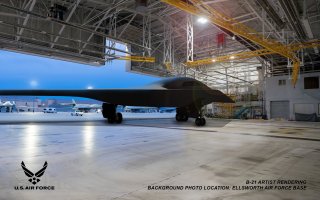Russia and China vs. New B-21 Stealth Bomber: Who Wins?
Will B-21 air superiority hold up in the future and withstand the test of time when faced with evolving stealth-detecting enemy air defenses?
As the first-of-its-kind B-21 stealth bomber prepares for its first few test flights in coming months, many suspect the new stealth platform is quite possibly a paradigm-changing breakthrough platform introducing unprecedented stealth characteristics, computing, sensing, and weapons technologies.
The pace of technological change now informing new Russian and Chinese emerging weapons programs could correctly be described as something commanding attention at the Pentagon. With a global technological environment in which fast-arriving AI-enabled sensing, targeting, weaponry, and air defenses introduce new threats quickly, some wonder if the B-21 will be able to stay in front of yet-to-exist enemy weapons and air defenses years from now. If the B-21 is the most advanced and superior stealth platform ever to exist, will that still be true in ten years, as new enemy air defenses continue to arrive? Will B-21 air superiority hold up in the future and withstand the test of time when faced with evolving stealth-detecting enemy air defenses?
While of course virtually no specifics are available regarding the actual technological composition of the B-21 for security reasons, Air Force senior weapons developers have for many years said the aircraft will be able to hold any target, anywhere in the world at risk anytime. The question is if this is true at the moment, will it still be true in ten years. “Yes,” Air Force General Timothy Ray, Commander of Air Force Global Strike Command, told The Mitchell Institute for Aerospace Studies in a video interview.
The reason for this, Ray said, is because the B-21 is architected in a “modular” style using common technical standards and “open architecture” to quickly integrate any available upgrades. In many cases, software upgrades can introduce new weapons capacity, improve computer processing speed and sensor data analysis. The concept is to of course ensure that the platform is positioned to stay in front of new threats as they emerge, such as longer-range air defenses with more sensitive radar, digital networking, and greater ranges of detection frequencies. The Russian-built S-500 missile defense system, for example, is believed to operate at vastly improved ranges with much higher degrees of sensitivity and targeting capacity. Many of these new radars are now meshed together as nodes within an integrated digital web able to hand off and share returns, sensor data, and targeting information.
Assessing and refining the technical architecture of the B-21 is now underway at the Air Force Test Center, where developers are working to prepare for the new aircraft’s first official test flight. The first set of preliminary test flights is expected to heavily focus upon the sensing and computing sophistication of the B-21 with a mind to how it can improve.
“These systems are so complex. There will be basic airframe evaluations, proof or expansion of the flight envelope, and assessments of all of the mission systems that need to be proved out. With every aircraft, we have to feel confident that we meet our design specifications. With a program like the B-21 we are doing firsts,” Major General Christopher Azzano, Commander at the Air Force Test Center, told The National Interest in an interview earlier this year.
Kris Osborn is the Defense Editor for the National Interest. Osborn previously served at the Pentagon as a Highly Qualified Expert with the Office of the Assistant Secretary of the Army—Acquisition, Logistics & Technology. Osborn has also worked as an anchor and on-air military specialist at national TV networks. He has appeared as a guest military expert on Fox News, MSNBC, The Military Channel, and The History Channel. He also has a Master's Degree in Comparative Literature from Columbia University.
Image: Reuters

